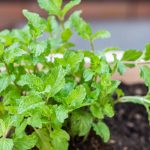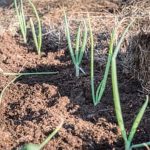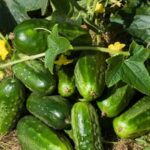Are you wondering when to lime vegetable gardens? Maintaining the right soil pH is crucial for the success of your vegetable garden. In this article, we will explore the significance of soil pH in vegetable gardens and provide valuable information on when and how to apply lime for optimal results.
The soil pH level plays a significant role in determining the health and productivity of your vegetable garden. It affects nutrient availability, microbial activity, and overall plant growth. Understanding how to properly manage soil pH is essential for ensuring that your vegetables receive the necessary nutrients for healthy development.
In the following sections, we will delve into the specifics of using lime to adjust soil pH in your vegetable garden. From understanding what lime is and its effects on soil pH to assessing if your garden needs lime and learning about different types of lime and their application, this article will equip you with all the essential knowledge to maintain a balanced and healthy soil pH for a thriving vegetable garden.
What Is Lime and How Does It Affect Soil pH?
Lime is a soil amendment made from ground limestone, which contains calcium carbonate and magnesium carbonate. When added to soil, lime works to increase the pH level, making the soil less acidic. This is important because many vegetable plants thrive in soil with a slightly acidic to neutral pH level, typically between 6.0 and 7.0.
There are two main types of lime commonly used in vegetable gardens: calcitic lime and dolomitic lime. Calcitic lime contains only calcium carbonate and is ideal for use in gardens where magnesium levels are already sufficient. On the other hand, dolomitic lime contains both calcium carbonate and magnesium carbonate, making it a good choice for soils that are also deficient in magnesium.
So how does lime affect soil pH? When added to the soil, the calcium or magnesium ions in the lime displace hydrogen ions from the soil particles, thereby raising the soil’s pH level. This process is essential for maintaining proper nutrient availability to plants and improving soil structure for healthy root development.
When considering whether to add lime to your vegetable garden, it’s important to first test your soil’s pH level using a simple at-home test kit or by sending a sample to a lab for analysis. Once you have determined that your soil is too acidic and could benefit from adding lime, it’s important to understand the different types of lime available and their specific application methods based on your soil composition.
The Benefits of Using Lime in Vegetable Gardens
Lime is a valuable soil amendment that offers several benefits when used in vegetable gardens. Here are some of the advantages of using lime in your garden:
- Adjusts Soil pH: One of the primary benefits of using lime is its ability to raise soil pH. Many vegetables thrive in soil with a slightly acidic to neutral pH level, and adding lime can help achieve this balance.
- Enhances Nutrient Availability: Proper soil pH is crucial for the availability of essential nutrients to plants. By maintaining optimal pH levels with the use of lime, you ensure that your vegetable plants have access to vital nutrients for their growth and development.
- Improves Soil Structure: Lime also plays a role in improving soil structure by reducing the acidity. This creates a favorable environment for beneficial microorganisms and earthworms, which contribute to healthy soil.
In addition to these benefits, using lime in your vegetable garden can also help reduce the toxicity of aluminum and manganese in the soil, which can be harmful to plant growth. By understanding these advantages, you can make an informed decision about incorporating lime into your gardening practices.
When considering whether to use lime in your vegetable garden, it’s essential to assess your specific soil conditions and consider the types of vegetables you plan to grow. Once you understand the potential benefits of using lime, you can proceed with testing your soil’s pH and determining if liming is necessary for your vegetable garden.
Assessing Soil pH
Before applying lime to your vegetable garden, it is important to assess the soil pH to determine if your garden actually needs it. Soil pH affects how well plants can take up nutrients from the soil, and most vegetables thrive in a slightly acidic soil with a pH between 6.0 and 7.0. There are several methods you can use to test the soil pH of your garden.
One common method is using a home testing kit, which usually involves mixing a small amount of soil with a testing solution and comparing the color of the resulting mixture to a color chart. Another option is to send a soil sample to a professional lab for more accurate results.
Some local cooperative extension offices also offer soil testing services at affordable prices. Whichever method you choose, make sure to take samples from various areas of your garden as some sections may have different pH levels.
After testing the soil, if the results show that your garden’s pH level is below 6.0, it means the soil is too acidic and may benefit from liming. On the other hand, if the pH level exceeds 7.0, it indicates alkaline soil and may not require lime application. By conducting regular soil tests, you can monitor changes in pH levels over time and make informed decisions on whether or not to apply lime to your vegetable garden.
Understanding the Different Types of Lime and Their Application
Quicklime
Quicklime, also known as burnt lime, is a highly reactive form of lime. It is not commonly used in vegetable gardens due to its caustic nature and potential to cause injury. Quicklime reacts vigorously with water, making it unsuitable for direct application in the garden. However, it can be used in certain industrial processes and for soil stabilization in some agricultural applications.
Dolomitic Lime
Dolomitic lime is a type of liming material that contains both calcium carbonate and magnesium carbonate. This makes it a great option for gardens with low magnesium levels, as it can help to correct any deficiencies while also raising the soil pH. Dolomitic lime is slower to react with the soil than other forms of lime, so it is best applied well before planting to allow time for it to break down and take effect.
Hydrated Lime
Hydrated lime, also known as calcium hydroxide, is another common form of lime used in vegetable gardens. This type of lime is fast-acting and requires caution when applying, as it can burn plants if not used properly. Hydrated lime should be mixed thoroughly into the soil to prevent any negative effects on plant roots. Its quick action makes it a popular choice for quickly adjusting soil pH, but frequent testing is required to avoid over-application.
When selecting the type of lime for your vegetable garden, consider both your current soil conditions and long-term goals for improving soil fertility. It’s essential to follow recommended application rates and monitor the effects on soil pH over time to ensure that you are achieving the desired results without causing harm to your plants or disrupting nutrient balance.
When Is the Best Time to Apply Lime to Vegetable Gardens?
So, when is the best time to apply lime to your vegetable garden? The ideal timing for applying lime to vegetable gardens is in the fall or early spring. This allows the lime to have enough time to dissolve and react with the soil before you start planting your vegetables.
By applying lime in the fall, it has all winter to break down and begin raising the pH of the soil. This ensures that by the time spring arrives and you are ready to plant, your soil will be at the optimal pH level for your vegetables.
Fall Application
Applying lime in the fall gives it time to interact with the soil over the winter months. It also allows snow, rain, and frost to help break down and distribute the lime more evenly throughout your garden.
Early Spring Application
If you missed out on applying lime in the fall, don’t worry – early spring is also a great time to apply it. Again, this gives the lime enough time to react with the soil before you start planting. However, keep in mind that it’s best not to apply lime too close to when you plan on planting as it may affect germination.
It’s important to note that applying lime in extreme temperatures (hot or freezing) should be avoided. It’s best to apply lime on a day where there is no precipitation forecasted so that it has enough time to begin reacting with the soil without being washed away. By applying lime at these times, you can ensure that your vegetable garden will have healthy and balanced pH levels for successful growth.
Step-by-Step Guide
Applying lime to your vegetable garden can be a crucial step in maintaining the proper soil pH for healthy plant growth. Once you have tested your soil and determined that it could benefit from the application of lime, it’s important to know the best practices for applying it properly.
The first step is to calculate the amount of lime needed for your specific garden area. This can be done by following the recommendations provided on your soil test results. It’s important to use an accurate measurement of the size of your garden, as adding too much or too little lime can have negative effects on your soil pH.
Next, choose the right time to apply the lime. Fall is generally considered the best time to apply lime to vegetable gardens, as it allows several months for it to become effective before planting in the spring. However, if you missed this window, applying lime in early spring is also acceptable before planting season begins.
Once you have determined the amount and timing for applying lime, spread it evenly across the surface of your garden using a shovel or spreader. After spreading, gently rake the surface to incorporate the lime into the top few inches of soil.
Watering lightly after application can also help activate and distribute the lime more effectively throughout the soil. Following these steps ensures proper distribution and effectiveness of the lime in adjusting your soil’s pH levels for optimal vegetable growth.
Monitoring and Adjusting Soil pH After Applying Lime
Once you have applied lime to your vegetable garden, it is important to monitor and adjust the soil pH to ensure that it remains at the optimal level for your plants. Regular monitoring of soil pH can help you determine if additional lime is needed or if other amendments are required to maintain healthy soil conditions.
One way to monitor soil pH is by conducting a routine soil test using a pH testing kit. These kits are readily available at gardening supply stores and provide an easy and accurate way to measure the acidity or alkalinity of your soil. By testing different areas of your garden, you can identify any fluctuations in pH levels and take appropriate action as needed.
In addition to using a pH testing kit, it is also recommended to observe the health and growth of your vegetable plants. If you notice any signs of nutrient deficiencies, stunted growth, or yellowing leaves, these may be indicators of imbalanced soil pH. In such cases, adjusting the soil pH through additional lime applications or other organic amendments may be necessary.
| Soil Test Results | Action Needed |
|---|---|
| pH 5 (Acidic) | Apply more lime or dolomitic limestone |
| pH 8 (Alkaline) | Refrain from applying more lime; consider adding organic matter like compost or peat moss |
Common Mistakes to Avoid When Using Lime in Vegetable Gardens
When it comes to the application of lime in vegetable gardens, there are common mistakes that gardeners should avoid in order to ensure the effectiveness of this soil amendment. One of the most common mistakes is applying too much lime. Over-liming can raise the soil pH to levels that are harmful to plants, inhibiting the availability of essential nutrients. It’s important to follow recommended application rates based on your soil test results.
Another mistake to avoid is applying lime at the wrong time. Applying lime too close to planting time can lead to nutrient imbalances and interfere with plant growth. It is best to apply lime several months before planting to allow it enough time to react with the soil and adjust pH levels accordingly.
Additionally, failing to retest the soil pH after applying lime is a mistake that can impact the overall health of your vegetable garden. The application of lime should be seen as an ongoing process, as soil pH can change over time. Regular testing and adjustment will help maintain optimal growing conditions for your vegetables.
By being mindful of these common mistakes and following best practices for using lime in vegetable gardens, you can effectively improve soil pH and create a conducive environment for healthy plant growth.
| Common Mistakes | Impact |
|---|---|
| Applying too much lime | Raised soil pH levels, inhibited nutrient availability |
| Applying at the wrong time | Interfered with plant growth and nutrient balance |
| Failing to retest soil pH after application | Potential imbalances in soil pH over time |
Conclusion
In conclusion, maintaining healthy soil pH is crucial for the success of a vegetable garden. By understanding the importance of soil pH and how it affects plant growth, gardeners can make informed decisions about when and how to apply lime to their gardens. The benefits of using lime, such as improved nutrient availability and root development, make it a valuable tool for gardeners looking to optimize their soil conditions.
Furthermore, proper assessment of soil pH through testing is essential in determining the need for lime application. By utilizing the different types of lime available and following recommended application methods, gardeners can effectively adjust and maintain the pH levels in their vegetable gardens. Additionally, ongoing monitoring after applying lime will ensure that the desired pH levels are achieved and maintained over time.
In summary, by following best practices for applying and managing lime in vegetable gardens, gardeners can create an optimal growing environment for their plants. Avoiding common mistakes and regularly testing and adjusting soil pH will result in healthier plants, higher yields, and ultimately, a successful vegetable garden. With the right knowledge and tools at their disposal, gardeners can enjoy the benefits of maintaining healthy soil pH for years to come.
Frequently Asked Questions
Which Vegetables Do Not Like Lime?
Some vegetables, such as potatoes, carrots, and peppers, do not thrive in acidic soil and may not respond well to added lime. These vegetables prefer a more neutral pH level in the soil for optimal growth.
How Do I Know if My Vegetable Garden Needs Lime?
The best way to determine if your vegetable garden needs lime is by conducting a soil test. This test will measure the pH level of the soil and indicate whether it is too acidic for proper vegetable growth. If the pH level is below 6.0, adding lime may be necessary to raise the pH level and balance the soil.
Can You Put Too Much Lime on a Vegetable Garden?
Yes, it is possible to put too much lime on a vegetable garden. Over-liming can raise the soil’s pH level to an excessive amount, which can negatively affect the availability of certain nutrients essential for plant growth.
It’s important to follow the recommendations from a soil test or consult with a gardening expert to ensure that you are applying only the necessary amount of lime for your specific vegetable garden.

If you’re looking to get into vegetable gardening, or are just looking for some tips on how to make your current garden better, then you’ve come to the right place! My name is Ethel and I have been gardening for years. In this blog, I’m going to share with you some of my best tips on how to create a successful vegetable garden.





